Children's and young adult trade books—both fiction and nonfiction—offer avenues through which readers can explore fascinating topics in various content areas. Here is a selection of books with curriculum connections to science and social studies that are sure to entice readers and to foster curiosity and critical thinking.
Ages 4–8
A Mammal Is an Animal. Lizzy Rockwell. 2018. Holiday House.
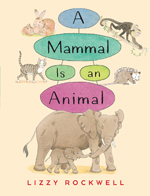 This introduction to mammals for young children features ink-and-watercolor illustrations rendered in soft hues. Lizzy Rockwell describes the characteristics of mammals in an engaging manner as she makes the point that, while all mammals are animals, not all animals are mammals. She also clearly shows that all mammals are not the same, singling out “some strange mammals” such as egg-laying monotremes—duckbill platypus, short-beaked echidna, and long-beaked echidna—and pouched marsupials—koalas, Virginia opossums, and kangaroos. Sure to fly off the classroom library shelves, A Mammal Is an Animal is an informative addition to a collection of books about animals.
This introduction to mammals for young children features ink-and-watercolor illustrations rendered in soft hues. Lizzy Rockwell describes the characteristics of mammals in an engaging manner as she makes the point that, while all mammals are animals, not all animals are mammals. She also clearly shows that all mammals are not the same, singling out “some strange mammals” such as egg-laying monotremes—duckbill platypus, short-beaked echidna, and long-beaked echidna—and pouched marsupials—koalas, Virginia opossums, and kangaroos. Sure to fly off the classroom library shelves, A Mammal Is an Animal is an informative addition to a collection of books about animals.
Tails (Question and Animal). 2018. Flowerpot Press.
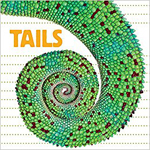 For readers not quite ready for Steve Jenkins’ What Do You Do with a Tail Like This? (2003), this board book introduces young readers to animals that can be identified by their tails. Young children are presented with textual and visual clues concerning the striking tails of five different animals (peacock, lemur, chameleon, beaver, and whale) and asked which animal has such a tail. There are three more board books in this series, each focusing on another body part of animals: Ears (2018), Feet (2018), and Noses (2018).
For readers not quite ready for Steve Jenkins’ What Do You Do with a Tail Like This? (2003), this board book introduces young readers to animals that can be identified by their tails. Young children are presented with textual and visual clues concerning the striking tails of five different animals (peacock, lemur, chameleon, beaver, and whale) and asked which animal has such a tail. There are three more board books in this series, each focusing on another body part of animals: Ears (2018), Feet (2018), and Noses (2018).
Ages 9–11
Rodent Rascals. Roxie Munro. 2018. Holiday House.
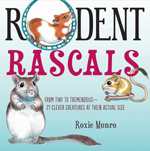 Although some might describe them as “rascals,” rodents are nonetheless fascinating, as this book demonstrates. With India and acrylic ink illustrations of the 21 featured rodents, Roxie Munro introduces readers to the diverse group of mammals in the order Rodentia, which vary in size, shape, behavioral characteristics, and habitat. Moving from diminutive to massive, the book begins with the small pygmy jerboa and concludes with the capybara, the world's largest rodent. Along the way, readers will learn interesting facts about rodents, such as how one rodent—the earth-tunneling naked mole rat—has lips behind its teeth. Another, the African giant pouched rat, has such a well-developed sense of smell that it can search out explosives and detect tuberculosis. Readers will finish the book with a different perspective on rodents.
Although some might describe them as “rascals,” rodents are nonetheless fascinating, as this book demonstrates. With India and acrylic ink illustrations of the 21 featured rodents, Roxie Munro introduces readers to the diverse group of mammals in the order Rodentia, which vary in size, shape, behavioral characteristics, and habitat. Moving from diminutive to massive, the book begins with the small pygmy jerboa and concludes with the capybara, the world's largest rodent. Along the way, readers will learn interesting facts about rodents, such as how one rodent—the earth-tunneling naked mole rat—has lips behind its teeth. Another, the African giant pouched rat, has such a well-developed sense of smell that it can search out explosives and detect tuberculosis. Readers will finish the book with a different perspective on rodents.
The Triumphant Tale of the House Sparrow. Jan Thornhill. 2018. Groundwood/House of Anansi.
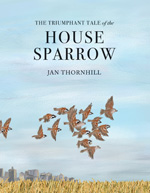 Handsome digital illustrations accompany the lively text that evokes sympathy for the house sparrow, considered a nuisance by many. Jan Thornhill describes this species’ earliest beginnings, its adaptations to environmental changes triggered by shifting agricultural practices, the disastrous results of China’s extermination, and other possible causes for the bird's decline. It's impressive how the house sparrow—an invasive species in the United States—has managed to adapt and survive for centuries, only to be faced with new challenges. The extensive back matter includes a map showing where sparrows originated and where they can be found today.
Handsome digital illustrations accompany the lively text that evokes sympathy for the house sparrow, considered a nuisance by many. Jan Thornhill describes this species’ earliest beginnings, its adaptations to environmental changes triggered by shifting agricultural practices, the disastrous results of China’s extermination, and other possible causes for the bird's decline. It's impressive how the house sparrow—an invasive species in the United States—has managed to adapt and survive for centuries, only to be faced with new challenges. The extensive back matter includes a map showing where sparrows originated and where they can be found today.
Turtle Pond. James Gladstone. Ill. Karen Reczuch. 2018. Groundwood/House of Anansi.
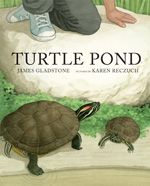 Based partly on the author's experiences at a turtle pond in Toronto, the book evokes curiosity as well as a sense of wonder and respect for these long-surviving reptiles. Created with graphite pencil and watercolors, the illustrations depict turtles as they move through the water, clamber onto rocks, soak up the sun, and gobble up their food. Because the story is told from the perspective of a young boy whose family visits the turtle pond quite often, readers can tell that these turtles matter to him and that he sees them as individuals, some slower and shyer than others and some more adventurous. An author’s note identifies the turtles featured in the book as Red-eared Sliders.
Based partly on the author's experiences at a turtle pond in Toronto, the book evokes curiosity as well as a sense of wonder and respect for these long-surviving reptiles. Created with graphite pencil and watercolors, the illustrations depict turtles as they move through the water, clamber onto rocks, soak up the sun, and gobble up their food. Because the story is told from the perspective of a young boy whose family visits the turtle pond quite often, readers can tell that these turtles matter to him and that he sees them as individuals, some slower and shyer than others and some more adventurous. An author’s note identifies the turtles featured in the book as Red-eared Sliders.
Ages 12–14
I Was Cleopatra. Dennis Abrams. 2018. Groundwood/House of Anansi.
 As almost anyone familiar with Elizabethan period drama knows, young boys played female characters—as women were forbidden, by law, to act in the theatre. But their acting careers were often short, lasting only as long as their facial hair was nonexistent or until their voices began to change, thus, destroying the illusion of femininity. In this fictional memoir of John Rice, an Elizabethan child actor, readers are given a glimpse into what life was like as he honed his stagecraft. For various reasons, including his recitation skills and his ability to memorize lines quickly, John leaves his home at 13 to join the King's Men in London as an apprentice, eventually playing roles as Cleopatra, Lady Macbeth, and Desdemona, among others. Many passages of this book reference the migratory nature of acting in the Elizabethan period as well as the plague that often reduced the population of large cities such as London, making it impossible for the troupe to eke out a living since theaters were closed.
As almost anyone familiar with Elizabethan period drama knows, young boys played female characters—as women were forbidden, by law, to act in the theatre. But their acting careers were often short, lasting only as long as their facial hair was nonexistent or until their voices began to change, thus, destroying the illusion of femininity. In this fictional memoir of John Rice, an Elizabethan child actor, readers are given a glimpse into what life was like as he honed his stagecraft. For various reasons, including his recitation skills and his ability to memorize lines quickly, John leaves his home at 13 to join the King's Men in London as an apprentice, eventually playing roles as Cleopatra, Lady Macbeth, and Desdemona, among others. Many passages of this book reference the migratory nature of acting in the Elizabethan period as well as the plague that often reduced the population of large cities such as London, making it impossible for the troupe to eke out a living since theaters were closed.
Journeys: Tales of Travel and Trailblazers. Jonathan Litton. Ill. Chris Chalik, Dave Shephard, Jon Davis, & Leo Hartas. 2018. 360 Degrees/Tiger Tales.
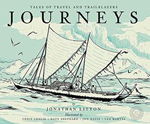 North, south, east, and west—no matter where they live, humans have often longed to travel and to learn what lies just over the next mountain, down the nearby river, beneath the sea, or even outside our planet’s orbit. This oversized book provides a fascinating introduction to the world’s explorers. Jonathan Litton includes the “journeys” of adventurers, both men and women, from different parts of the world. The book's organization into sections—"Water," "Land," "Ice and Snow," and "Man and Machine"—helps readers consider just how much these trailblazers have contributed to what we know about our world. Starting with a 17th-century sailor reputed to have explored the Antarctic region and concluding with the lunar orbit, the book offers just enough detail to tantalize readers. The inclusion of a list of references, a timeline, and suggested reading would have been helpful for finding out more about these journeys.
North, south, east, and west—no matter where they live, humans have often longed to travel and to learn what lies just over the next mountain, down the nearby river, beneath the sea, or even outside our planet’s orbit. This oversized book provides a fascinating introduction to the world’s explorers. Jonathan Litton includes the “journeys” of adventurers, both men and women, from different parts of the world. The book's organization into sections—"Water," "Land," "Ice and Snow," and "Man and Machine"—helps readers consider just how much these trailblazers have contributed to what we know about our world. Starting with a 17th-century sailor reputed to have explored the Antarctic region and concluding with the lunar orbit, the book offers just enough detail to tantalize readers. The inclusion of a list of references, a timeline, and suggested reading would have been helpful for finding out more about these journeys.
The Radical Element. Jessica Spotswood (Ed.) 2018. Candlewick.
 Although sometimes it might seem that progress in women’s rights has been slow, this anthology about a diverse group of young women provides some perspective on how far we’ve come. Starting with a short story set in 1838 in Savannah, Georgia, an Orthodox Jewish girl named Rebekah leaves her home to pursue the education she craves, and concluding with a story set in 1984 in Boston, Massachusetts, about an immigrant girl who joins a feminist punk band, 12 young adult authors share stories about girls and women who found their voices, despite fears and consequences. Most compelling are Erin Bowman’s "The Magician," which features a protagonist who pretends to be a male; Mackenzi Lee’s "You're a Stranger Here," which highlights one Mormon girl's doubts about her faith; and Megan Shepard’s "Lady Firebrand," which features two Union spies. Perhaps this intriguing collection will encourage girls to embrace their best selves and to engage in radical actions of their own.
Although sometimes it might seem that progress in women’s rights has been slow, this anthology about a diverse group of young women provides some perspective on how far we’ve come. Starting with a short story set in 1838 in Savannah, Georgia, an Orthodox Jewish girl named Rebekah leaves her home to pursue the education she craves, and concluding with a story set in 1984 in Boston, Massachusetts, about an immigrant girl who joins a feminist punk band, 12 young adult authors share stories about girls and women who found their voices, despite fears and consequences. Most compelling are Erin Bowman’s "The Magician," which features a protagonist who pretends to be a male; Mackenzi Lee’s "You're a Stranger Here," which highlights one Mormon girl's doubts about her faith; and Megan Shepard’s "Lady Firebrand," which features two Union spies. Perhaps this intriguing collection will encourage girls to embrace their best selves and to engage in radical actions of their own.
Ages 15+
Boots on the Ground: America’s War in Vietnam. Elizabeth Partridge. 2018. Viking/Penguin.
 Complemented with archival photographs, Elizabeth Partridge’s well-documented story of the Vietnam War is presented from the perspectives of eight individuals she interviewed: six American soldiers, a nurse, and a refugee. Because the accounts appear in chronological order, interspersed with vignettes concerning the men who led the country during those times—John F. Kennedy, Lyndon B. Johnson, Richard M. Nixon, and Gerald R. Ford—as well as other influential individuals such as civil rights activist Martin Luther King, Jr., and musician Country Joe Fish, readers are plunged deep into the conflict as the nation became increasingly divided. Even those who avoid history will find themselves compelled to read every story included.
Complemented with archival photographs, Elizabeth Partridge’s well-documented story of the Vietnam War is presented from the perspectives of eight individuals she interviewed: six American soldiers, a nurse, and a refugee. Because the accounts appear in chronological order, interspersed with vignettes concerning the men who led the country during those times—John F. Kennedy, Lyndon B. Johnson, Richard M. Nixon, and Gerald R. Ford—as well as other influential individuals such as civil rights activist Martin Luther King, Jr., and musician Country Joe Fish, readers are plunged deep into the conflict as the nation became increasingly divided. Even those who avoid history will find themselves compelled to read every story included.
What the Night Sings. Vesper Stamper. 2018. Alfred A. Knopf/Random House.
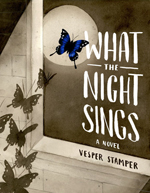 After being liberated from Bergen-Belsen “displaced persons camp” in 1945, 16-year-old Gerta must find a way to go on despite the many losses she has experienced during the war. The strength necessary to survive the horrors of the concentration camps and the eradication of one’s identity are themes explored here as Gerta connects with Lev, another survivor, and is aided by Micah in reaching Palestine. The power of music to heal is ever present in the lines of Gerta’s unique and riveting story. Accompanied by stark illustrations, rendered in ink wash, white gouache, and graphite, this novel is an account of hope even in the face of great evil. Back matter includes an extensive author’s note, glossary, maps, and resources (films, books, websites, places to visit, and music).
After being liberated from Bergen-Belsen “displaced persons camp” in 1945, 16-year-old Gerta must find a way to go on despite the many losses she has experienced during the war. The strength necessary to survive the horrors of the concentration camps and the eradication of one’s identity are themes explored here as Gerta connects with Lev, another survivor, and is aided by Micah in reaching Palestine. The power of music to heal is ever present in the lines of Gerta’s unique and riveting story. Accompanied by stark illustrations, rendered in ink wash, white gouache, and graphite, this novel is an account of hope even in the face of great evil. Back matter includes an extensive author’s note, glossary, maps, and resources (films, books, websites, places to visit, and music).
Barbara A. Ward teaches graduate and undergraduate courses in literacy at Washington State University, Pullman. She spent 25 years teaching in the public schools of New Orleans, where she worked with students at every grade level, from kindergarten through high school as well as several ability levels. She is certified in elementary education, English education, and gifted education. She holds a bachelor's in Communications, a master's in English Education from the University of Tennessee and a PhD in Curriculum and Instruction from the University of New Orleans.
These reviews are submitted by members of the International Literacy Association's Children's Literature and Reading Special Interest Group (CL/R SIG) and are published weekly on Literacy Daily.